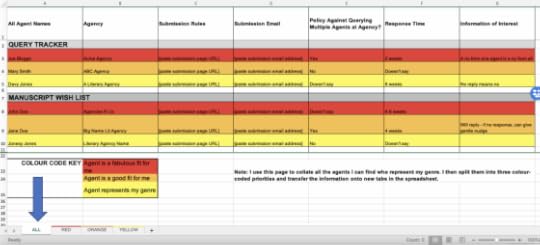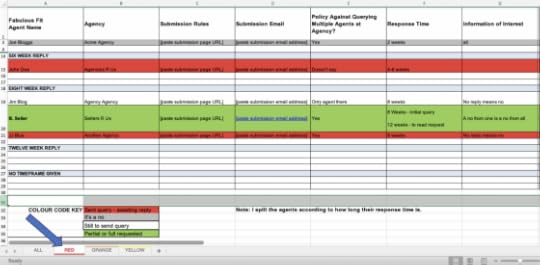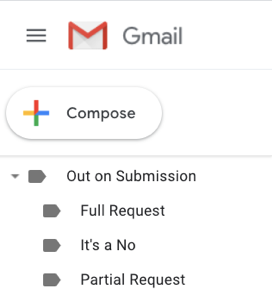Here’s a System and Template for Tracking Your Submissions (Bonus: It Reduces the Sting of Rejection)
 Photo credit: lealingo on Visual Hunt / CC BY-NC-ND
Photo credit: lealingo on Visual Hunt / CC BY-NC-NDToday’s post is by author Emma Lombard (@LombardEmma).
Throwing your new manuscript into the query trenches can be an exhilarating but nerve-crushing experience. I use a systematic and business-like approach to help take the sting out of rejections and keep me focused on moving forward with querying.
Before querying, I ensure my manuscript has been through multiple revisions, critique partners, beta readers and edits to give it its best shot. I also have a polished and professionally critiqued query letter.
1. Find agents who represent your genre
Here are some sites where you can research agents online:
Query Tracker: free service that has a paid option
Manuscript Wish List: aggregates agent and editor conversations that happen on Twitter using the hashtag #mswl
Publishers Marketplace ($25/month)
#PitMad pitch parties on Twitter
Helpful Hint: Properly screening the right agents takes an extraordinary amount of time! Start collating your list of agents during your breaks while you are finishing off the last of your revisions or edits on your manuscript, or else this task will seem monumental if you leave it to the last minute.
2. Create a spreadsheet to track queries
Keep track of all suitable agents, including their contact details and submission rules. Here’s a ready-made tracking spreadsheet template for you to download. Feel free to modify it as required.
How to Use the Spreadsheet or Set Up Your Own
First, I create four tabs on my spreadsheet. On the first tab, “All,” list all agents who represent your genre. Categorize agents depending on where their details are found, and fill out the info in the corresponding columns.
 Columns under the ALL tab
Columns under the ALL tabAgent Name
Agency
Submission URL: I don’t enter submission details into the spreadsheet in case they change. I refer to the live URL when the time comes to query that agent.
Submission email: this might be different from the agent’s normal email address
Policy on querying multiple agents at the agency
Response time
Information of interest: jot down any interesting tidbits along the way
Within each category, prioritize the agents by highlighting them:
Red: agent is a fabulous fit for me
Orange: agent is a good fit for me
Yellow: agent represents my genre
Helpful Hint: Even if an agent is currently closed to queries, still add them to your spreadsheet. By the time you get around to querying, they may be open again.
 Your other tabs: red, orange and yellow
Your other tabs: red, orange and yellowNext: Transfer the color-coded agents from the ALL Tab onto their own tabulated sheets (red, orange, yellow). Remove all the color highlights after you do this.
Then: Categorize the agents by their response timeframes. Send out queries in batches of ten, ensuring they have different response times, so that responses will start to roll in at different times.
Then I color code the query rows based on the status; I change the color as new information comes in. These are the colors that I use:
Red: Query sent, awaiting reply
Green: Partial or full request
No color: Still need to send query
Gray: No
I add the following columns of information:
Date first queried
Requested materials sent
Date to follow up
Date to cancel query
Response
If a rejection comes in, highlight the agent gray and immediately send a new query out to another agent. Try to keep ten queries out there at all times. Keep the rejected agents on the spreadsheet so as not to double query them.

Helpful Hint: In the Red, Orange and Yellow categories, pick your top 10 agents who you’d like to query first and place them at the top of the spreadsheets.
3. Create separate email folders
To keep track of all the emails that come and go, create a main folder with subfolders in the email menu so that they don’t clutter up in the sent and in boxes.
Out on submission: for all sent email queries
Full request: to see who is reading fulls
No: move all correspondence for an agent who says no into this folder
Partial request: to see who is reading partials

Helpful Hint: Set a goal of how many agents you plan to query. For example, I have screened and collated 170 world-wide agents on my three color-coded spreadsheets, and I’m not giving up until I’ve queried every single one of them!
Remember, it’s just business
I find that by using a systematic color-coding system to track queries, and by filing my emails, it’s not as disheartening when a query is rejected because I have a call to action in place to immediately send another query out.
Getting into a business frame of mind helps. It’s a bit like keeping a balance sheet: money in—money out. Or submitting bids: you win some—you lose some. My favorite quote from a literary agent on the topic of query rejections is from Janet Reid (aka The Query Shark), on her Rules for Writers guest post on my blog:
.ugb-0634daf .ugb-blockquote__quote{width:70px !important;height:70px !important}.ugb-0634daf .ugb-inner-block{text-align:left}.ugb-0634daf.ugb-blockquote{margin-top:47px !important;margin-bottom:-49px !important;padding-bottom:0px !important}I tell you this here to illustrate one more time that when you query agents and you get a form rejection, it’s not always about YOU. It could be about ME.
It’s ME if I’m not enamored of the topic no matter how well written;
It’s ME if I’m overwhelmed with work this week, and just can’t read one more partial;
It’s ME if I’ve got a project very similar to yours and can’t sell it for spit;
It’s ME if I can’t think of an editor who would buy this book and have no idea where to even start;
It’s ME if a colleague handles this genre and I don’t want to encroach on his/her turf.
I don’t tell you any of this, and I don’t apologize for using a form rejection in these cases. I do, and you’ll just have to know that.
Janet’s advice helps me focus on the fact that a query rejection is not personal—it’s just business!
Jane Friedman
- Jane Friedman's profile
- 1882 followers



